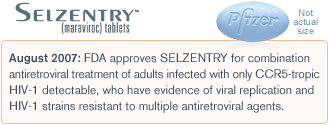| Maraviroc
(Selzentry) Is Associated with Faster and Larger CD4 Cell Gains: MERIT Trial By
Liz Highleyman The
CCR5 antagonist maraviroc
(Selzentry) works by blocking one of the 2 co-receptors HIV uses to enter
cells (CCR5 and CXCR4). As
previously reported, researchers presented data at the 48th
International Conference on Antimicrobial Agents and Chemotherapy (ICAAC 2008)
last week showing that in the MERIT study, maraviroc worked as well as efavirenz
(Sustiva) in treatment-naive patients when a more sensitive tropism test was
used to exclude people whose virus uses the CXCR coreceptor. 
At
the same meeting, investigators also reported data from a post-hoc analysis of
CD4 cell recovery in this trial, elaborating on earlier findings suggesting that
maraviroc may promote larger CD4 cell gains. Briefly,
the international MERIT trial included 721 participants starting antiretroviral
therapy for the first time. About 70% were men, just over half were white,
and about 35% were black. At baseline, the median CD4 cell count was about 250
cells/mm3 and the mean viral load was about 700,000 copies/mL. Participants were
randomly assigned to receive either 300 mg twice-daily maraviroc or 600 mg once-daily
efavirenz, both in combination with zidovudine/lamivudine
(Combivir coformulation) for 48 weeks. Results
•
Significantly larger and faster CD4 cell
increases were observed in patients receiving maraviroc versus efavirenz.
•
At week 4, the median CD4 cell gain from
baseline was 77 cells/mm3 in the maraviroc arm compared with 47 cells/mm3 in the
efavirenz arm (P = 0.0001).
•
At 48 weeks, the median CD4 cell increase
was 151 cells/mm3 in the maraviroc arm compared with 122 cells/mm3 in the efavirenz
arm (P = 0.0017).
•
Patients taking maraviroc also experienced
a rapid CD8 cell gain, which leveled off at 28 cells/mm3, while those taking efavirenz
experienced a CD8 cell decline of 110 cells/mm3.
•
A larger percentage of patients in the
maraviroc arm who started with < 200 CD4 cells/mm3 achieved >200
cells/mm3 by week 48 (79% vs 71%).
•
Participants taking maraviroc were less
likely to experience a discordant response, that is, viral load suppression without
significant CD4 cell recovery.
•
Among patients who did not achieve HIV
RNA < 50 copies/mL at week 48, fewer maraviroc recipients developed a Category
C AIDS-defining event compared with efavirenz recipients (1% vs 9%; P = 0.007).
•
Among these non-responders, the median
CD4 cell gains were 64 cells/mm3 for maraviroc recipients versus 0 cells/mm3 for
efavirenz recipients.
"Patients
who received maraviroc in MERIT had faster and larger CD4+ cell increases,"
the researchers concluded. "More patients in the maraviroc arm were able
to cross clinically meaningful CD4+ thresholds by Week 48."
While
experts dispute the clinical significance of such small differences in CD4 cell
gains, in this study higher on-treatment CD4 counts were associated with a longer
time to an AIDS-defining event.
"This supports the premise that the
additional CD4+ cells conferred by maraviroc + Combivir were functional, and suggests
that antagonism of the CCR5 co-receptor by maraviroc was not associated with any
deleterious effect as measured by Category C events at 48 weeks," the investigators
noted.
Inst. di Ricerca e Cura a Carattere Scientifico S. Raffaele,
Milano, Italy; Univ. Hosp., Basel, Switzerland; Univ. of New South Wales, Sydney,
Australia; Dept. of Immunology & Infectious Diseases, INNSZ, Mexico City,
Mexico; Ottawa Hlth. Res. Inst., Ottawa, Canada; Univ. of Pennsylvania, Philadelphia,
PA; Desmond Tutu HIV Ctr., Cape Town, South Africa; Pfizer Global R&D, New
London, CT; Pfizer Inc., New York, NY. 11/7/08 Reference
A
Lazzarin, M Battegay, DA Cooper, and others. CD4+ cell restoration at 48weeks
in the maraviroc (MVC) treatment-naive (TN) MERIT trial. 48th International Conference
on Antimicrobial Agents and Chemotherapy (ICAAC 2008). Washington, DC. October
25-28, 2008. Abstract H-1248. |

![]()
